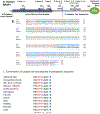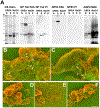BFSP1 C-terminal domains released by post-translational processing events can alter significantly the calcium regulation of AQP0 water permeability
- PMID: 30790544
- PMCID: PMC6713518
- DOI: 10.1016/j.exer.2019.02.001
BFSP1 C-terminal domains released by post-translational processing events can alter significantly the calcium regulation of AQP0 water permeability
Abstract
BFSP1 (beaded filament structural protein 1, filensin) is a cytoskeletal protein expressed in the eye lens. It binds AQP0 in vitro and its C-terminal sequences have been suggested to regulate the water channel activity of AQP0. A myristoylated fragment from the C-terminus of BFSP1 was found in AQP0 enriched fractions. Here we identify BFSP1 as a substrate for caspase-mediated cleavage at several C-terminal sites including D433. Cleavage at D433 exposes a cryptic myristoylation sequence (434-440). We confirm that this sequence is an excellent substrate for both NMT1 and 2 (N-myristoyl transferase). Thus caspase cleavage may promote formation of myristoylated fragments derived from the BFSP1 C-terminus (G434-S665). Myristoylation at G434 is not required for membrane association. Biochemical fractionation and immunogold labeling confirmed that C-terminal BFSP1 fragments containing the myristoylation sequence colocalized with AQP0 in the same plasma membrane compartments of lens fibre cells. To determine the functional significance of the association of BFSP1 G434-S665 sequences with AQP0, we measured AQP0 water permeability in Xenopus oocytes co-transfected with transcripts expressing both AQP0 and various C-terminal domain fragments of BFSP1 generated by caspase cleavage. We found that different fragments dramatically alter the response of AQP0 to different concentrations of Ca2+. The complete C-terminal fragment (G434-S665) eliminates calcium regulation altogether. Shorter fragments can enhance regulation by elevated calcium or reverse the response, indicative of the regulatory potential of BFSP1 with respect to AQP0. In particular, elimination of the myristoylation site by the mutation G434A reverses the order of water permeability sensitivity to different Ca2+ concentrations.
Copyright © 2019 The Authors. Published by Elsevier Ltd.. All rights reserved.
Figures







Similar articles
-
The effect of the interaction between aquaporin 0 (AQP0) and the filensin tail region on AQP0 water permeability.Mol Vis. 2011;17:3191-9. Epub 2011 Dec 13. Mol Vis. 2011. PMID: 22194645 Free PMC article.
-
Independent Membrane Binding Properties of the Caspase Generated Fragments of the Beaded Filament Structural Protein 1 (BFSP1) Involves an Amphipathic Helix.Cells. 2023 Jun 7;12(12):1580. doi: 10.3390/cells12121580. Cells. 2023. PMID: 37371051 Free PMC article.
-
Regulation of aquaporin water permeability in the lens.Invest Ophthalmol Vis Sci. 2005 Apr;46(4):1393-402. doi: 10.1167/iovs.04-1217. Invest Ophthalmol Vis Sci. 2005. PMID: 15790907
-
Insights into the beaded filament of the eye lens.Exp Cell Res. 2007 Jun 10;313(10):2180-8. doi: 10.1016/j.yexcr.2007.04.005. Epub 2007 Apr 6. Exp Cell Res. 2007. PMID: 17490642 Free PMC article. Review.
-
Structural function of MIP/aquaporin 0 in the eye lens; genetic defects lead to congenital inherited cataracts.Handb Exp Pharmacol. 2009;(190):265-97. doi: 10.1007/978-3-540-79885-9_14. Handb Exp Pharmacol. 2009. PMID: 19096783 Review.
Cited by
-
CRYAA and GJA8 promote visual development after whisker tactile deprivation.Heliyon. 2023 Feb 23;9(3):e13897. doi: 10.1016/j.heliyon.2023.e13897. eCollection 2023 Mar. Heliyon. 2023. PMID: 36915480 Free PMC article.
-
Bioinformatics identifies key genes and potential therapeutic targets in the pathological mechanism of oxidative stress in Randall's plaque.Sci Rep. 2024 Dec 28;14(1):31364. doi: 10.1038/s41598-024-82849-y. Sci Rep. 2024. PMID: 39732836 Free PMC article.
-
The major inducible small heat shock protein HSP20-3 in the tardigrade Ramazzottius varieornatus forms filament-like structures and is an active chaperone.Cell Stress Chaperones. 2024 Feb;29(1):51-65. doi: 10.1016/j.cstres.2023.12.001. Epub 2023 Dec 5. Cell Stress Chaperones. 2024. PMID: 38330543 Free PMC article.
-
Quantification of Age-Related Changes in the Lateral Organization of the Lipid Portion of the Intact Membranes Isolated from the Left and Right Eye Lenses of the Same Human Donor.Membranes (Basel). 2023 Feb 3;13(2):189. doi: 10.3390/membranes13020189. Membranes (Basel). 2023. PMID: 36837692 Free PMC article.
-
D348N Mutation of BFSP1 Gene in Congenital Cataract: it Does Matter.Cell Biochem Biophys. 2023 Dec;81(4):757-763. doi: 10.1007/s12013-023-01169-6. Epub 2023 Sep 4. Cell Biochem Biophys. 2023. PMID: 37667037
References
-
- Bologna G, Yvon C, Duvaud S, Veuthey AL, 2004. N-Terminal myristoylation predictions by ensembles of neural networks. Proteomics 4, 1626–1632. - PubMed
-
- Brunkener M, Georgatos SD, 1992. Membrane-binding properties of filensin, a cytoskeletal protein of the lens fiber cells. J. Cell Sci 103 (Pt 3), 709–718. - PubMed
Publication types
MeSH terms
Substances
Grants and funding
LinkOut - more resources
Full Text Sources
Other Literature Sources
Molecular Biology Databases
Research Materials
Miscellaneous

